【第六十六回目】
さるや:「クロモジ」香る、楊枝の老舗 Saruya: For 300 Years, Toothpicks with the Aroma of the Kuromoji tree
| セインさん、今日お訪ねするのは、日本橋の楊枝の専門店「さるや」さんです。宝永年間(1704~1710)の創業だそうです。 Thayne-san, today we’ll be visiting a shop that specializes in toothpicks in Nihonbashi called Saruya. It was founded in the Hoei period in the early 1700s. | |
| ……というと、300年以上の歴史! So that means it has a history of… over 300 years! | |
| はい、すごいでしょ。最近、日本橋の路地の中に本店を移されたのですが、知る人ぞ、知る、といった感じのロケーションがまたいいんです。 Yes, it’s quite amazing. They recently moved their head office to an alley in Nihonbashi. The fact that that it can only be found by people in the know makes it even more special. | |
| あ、「さるや」の暖簾が見えてきました。センスいいなあ。モダンでかっこいい! Ah, the Saruya noren have come into view. Wow, the shop looks really stylish. It’s so modern and cool looking! | |
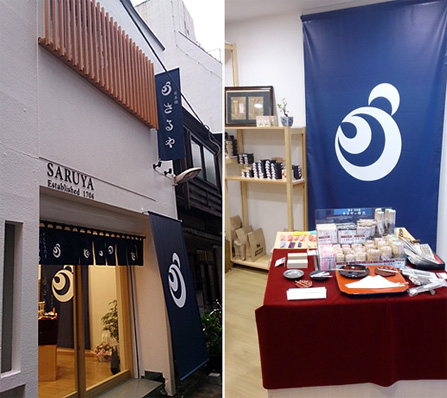 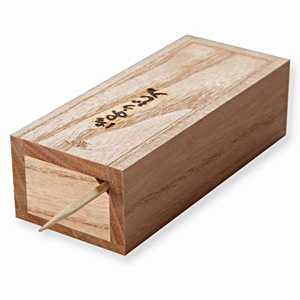 |
|
| (山本) | こんにちは、コンシェルジュさん、セインさん! 山本亮太です。 Hello, Concierge-san, Thayne-san. I’m Ryota Yamamoto. |
| こんにちは、山本さん。とても若いご主人なんですね。山本さんで何代目のご当主になるんですか。 Hello Mr. Yamamoto. You’re really quite young for a shop master. What generation are you? | |
| (山本) | 私で9代目です。 I’m the 9th. |
| 300年も続いていると聞いてびっくりしたのですが、楊枝に専門店があるということ自体も驚きです。 I was surprised to hear that you’ve been in business for 300 years, but actually I’m even more surprised that there’s a shop dealing exclusively in toothpicks. | |
| (山本) | 楊枝専門の店というのは、多分、世界でうち1軒だけだと思います。でも、江戸時代には、楊枝の専門店は珍しくなかったんですよ。 楊枝はもともと歯磨きの道具で日用品、消耗品でしたから、町のいたるところで売られていたんです。なかでも浅草寺の境内は楊枝屋が多いことで有名で、文化文政期(1806-1829)には200軒近くもあったそうなんです。 Well I think we may be the only toothpick specialty shop in the world these days. But in the Edo period, specialty toothpick shops were not uncommon. Toothpicks were everyday tools used for cleaning one’s teeth, and since they’re consumable goods they were sold everywhere. The grounds of Sensoji Temple were particularly famous for having lots of toothpick shops, and in the Bunsei Period (1806 – 1829) there were close to 200 shops. |
| ええっ、そんなに! Really! | |
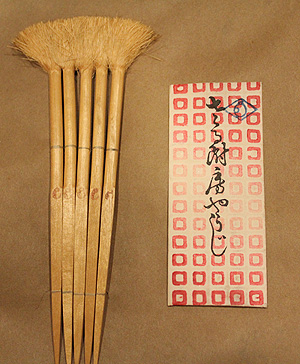 |
|
| 有名な絵図『江戸名所図会』などにも描かれているんです。当時、浅草寺の北には吉原遊郭があって、いなせな男は歯が白いのが絶対条件と言われていましたから、皆、セッセと歯を磨いたんでしょうね。 Toothpick shops also appear in the famous pictorial “Edo Meisho Zue.” (http://en.wikipedia.org/wiki/Edo_Meisho_Zue) At the time, the Yoshiwara red-light district(http://en.wikipedia.org/wiki/Yoshiwara) was to the north of Sensoji Temple (http://www.senso-ji.jp/about/index_e.html), and it was said that pearly white teeth were one of the firm requirements for women who chose to entertain the dashing men who patronized the district. So I guess everyone was busy brushing their teeth. | |
| 白い歯を見せて笑うとモテるのは、古今東西同じですね。 Showing a bright toothy smile is charming in any age and culture, I’m sure. | |
| (山本) | 実はうちの屋号の「さるや」も、“サルは歯が白い”ことにあやかって、つけられたようです。 Actually, our shop name came from the idea that monkeys have white teeth. |
| ああ! 不思議な名前だなあと思っていたんです。 Ah! I was thinking it was a slightly odd name for a toothpick shop. | |
| (山本) | はい。でも同じことは他の人も考えたようで、さるやと言えば楊枝屋、というくらい同名の店がたくさんあったそうです。看板にサルの絵を描いたり、本物のサルを店頭に座らせている店もあったりして……。 Yes. But a lot of other people seem to have thought the same thing, and when you hear the name “Saruya” (“monkey shop”) you know they sell toothpicks, to the degree that there were many shops with the same name. They would paint a picture of a monkey on their sign. One shop even sat a real monkey in the front. |
| ははは(笑) それにしても、何百軒もあった江戸の楊枝屋のなかで、この店だけが残ったわけですから、すごいですね。 Haha. Even so, it’s incredible that among the hundreds of toothpick shops in the Edo Period, only yours has survived. | |
| (山本) | 本当に、競争社会のなかでよく生き残ったと思います。 ただ、いつの頃からか、うちの楊枝はクロモジの木だけで作るようになったんです。楊枝には、ヤナギやシラカバなど、弾力があって折れにくい木が使われるんですが、クロモジはしなやかな上に、独特の香気があるんです。楊枝は口に触れるものですから、清涼感のある香りを持つクロモジは楊枝のなかでも最高の材料とされました。 Yes, I think we really have survived well among all the competition. At one point, we started to make our toothpicks using only wood from the kuromoji tree. Usually strong, stiff wood like willow or birch is used, but kuromoji wood has a characteristic scent in addition to being flexible. Since toothpicks are used in the mouth, the fresh scent of the kuromoji wood makes it the perfect material. |
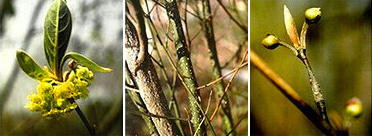 The kuromoji tree used for the toothpicks is a deciduous tree in the laurel family. 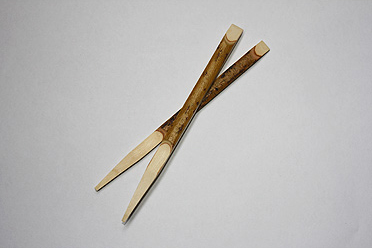 Kuromoji used for eating Japanese confections. |
|
| セインさん、クロモジの木は、上生菓子を食べる時に使う道具にも……。 Thayne-san, kuromoji is used to eat Japanese confections as well. | |
| 「黒文字」ですね! 黒い樹皮がアクセントになっていて、シンプルで美しい。自然から作られた、とても日本らしい道具だと思います。 Ah, kuromoji! The dark bark accents the sweets, it’s simple, natural, and beautiful. It’s very Japanese. | |
| (山本) | はい。ですが、クロモジで作ると材料代が高い上に、1本1本を手仕事で仕上げていくので、一般のものよりもずっと値段が高くなるんです。つまり、その高い商品をわざわざ買って使う「見栄っ張りの文化」に着目して、そういうお客様にめがけて工夫しながらやってきたのが、うちが300年も続いてきた理由なんだろうと思います。 Indeed. But not only is it expensive to use kuromoji, each individual toothpick must be finished by hand, so they’re much more expensive than other toothpicks. That means they appeal to big spenders, and those are the types of customers we designed our product for. I think it’s the reason we’ve been in business for 300 years. |
| なるほど。江戸っ子の「見栄っ張り」に目をつけたわけですね。 商品を見ると、楊枝を入れる紙袋や木箱も、ものすごく凝っているんですね! これは、人気が出るはずだ。 I see. The ostentatiousness really caught the eye of edokko. Looking at your products, I notice that you have paper bags and wooden boxes just for holding toothpicks, and they’re so elaborate! They must be really popular. | |
| セインさん、「さむらい楊枝」は、楊枝を巻いている小さな紙に、何か書いてありますよ。 「いざ参ろう。Let’s go.」 「たのもう。Hello, may I come in?」 おもしろーい! (笑) Thayne-san, the “samurai toothpicks” are wrapped in these small pieces of paper with messages on them. This one says, “Izamaro. Let’s go.” And, “Tanomo. Hello, May I come in?” They’re quite funny. | |
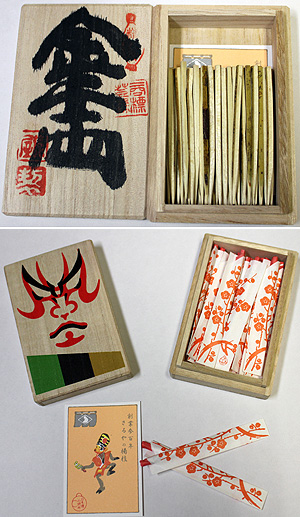 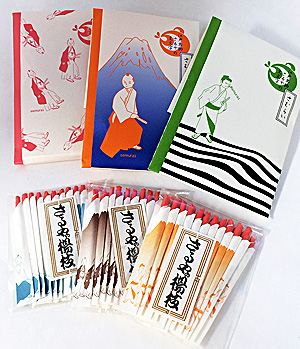 |
|
| それにしても、クロモジというのは、とてもおもしろい素材ですね。 Kuromoji really is an interesting material to use for toothpicks. | |
| (山本) | そうなんです。実はクロモジの様々な特徴を生かして、他にも何かできないかと、今、いろんな試みをしているところなんです。たとえば、クロモジのお酒とか。 Yes, I think so too. Kuromoji has a lot of characteristics, and we’ve been experimenting with other uses to see what else we can do with it. For example, we’ve started making sake. |
| お酒!? Sake!? | |
| (山本) | ええ。石川県の日本酒メーカーとのコラボレーションで、クロモジが香るお酒をいま造っている最中です。 That’s right. We’re working with a sake distillery in Ishikawa prefecture to make sake with the kuromoji aroma. |
| 出来上がったら、ちょっと飲んでみたいです。 When it’s ready, I’d love to have a taste. | |
| (山本) | ぜひ! Sure! |
| ところで山本さんは、お店を継ぐ前は、どこかで働いていらっしゃいましたか? By the way Yamamoto-san, prior to succeeding as a shop owner, did you work anywhere else? | |
| (山本) | はい。大学を出たあと、しばらく一般の企業に勤めていました。 Yes, after graduating from university, I worked at a private company for a time. |
| サラリーマンと家業では、どちらが大変ですか? 何か違いますか? Which is tougher, working at an office or managing the family business? How are they different? | |
| (山本) | うーん。僕にとっては、どちらも大変です(笑)。でも、「大変」の質が違うような気がします。 それに、家業を継いだとはいっても、まだ何も始まっていません。大きなこと、新しいことをやりたい。そのために、今は一生懸命に走っているという感じです。 Well, um, for me, both have been challenging. But I think they’re challenging in different ways. Although I’ve taken over as owner, nothing’s really begun yet. I want to do new, big things. To get ready for that, it feels like I’ve really been running at full speed.. |
| いいお話をありがとうございました。それに今日は、小さな楊枝の深い世界を、ちょっとのぞくことができた気がします。 じゃあ、里帰りのお土産を買って帰ろうかな。楽しかったです! It was great talking with you. I think today we’ve been able to get a peek at the deep world of little toothpicks. I think I’ll get some gifts for my family before we leave. Thanks again! | |
| (文)太田美代 (英訳)デイビッド・A・セイン |
 1959年、米国生まれ。翻訳家、通訳、英会話経営者(エートゥーゼット英語学校)。カリフォルニア州アズサパシフィック大学で社会学修士号取得。証券会社勤務を経て来日し、多岐にわたって活躍中。 豊富なアイディアと行動力、そして誠実な飾らぬ人柄も万人に愛されている。 著書に『その英語、ネイティブにはこう聞こえます』(主婦の友社)、『使ってはいけない英語』(河出書房新社)、『英語ライティングルールブック』(DHC)、『英語でしゃべらナイト』(NHK出版)など多数。『Mainichi Weekly』(毎日新聞社)の連載や『水は答えを知っている」(The Hidden Messages in Water)等の翻訳も好評。 http://www.smartenglish.co.jp/
1959年、米国生まれ。翻訳家、通訳、英会話経営者(エートゥーゼット英語学校)。カリフォルニア州アズサパシフィック大学で社会学修士号取得。証券会社勤務を経て来日し、多岐にわたって活躍中。 豊富なアイディアと行動力、そして誠実な飾らぬ人柄も万人に愛されている。 著書に『その英語、ネイティブにはこう聞こえます』(主婦の友社)、『使ってはいけない英語』(河出書房新社)、『英語ライティングルールブック』(DHC)、『英語でしゃべらナイト』(NHK出版)など多数。『Mainichi Weekly』(毎日新聞社)の連載や『水は答えを知っている」(The Hidden Messages in Water)等の翻訳も好評。 http://www.smartenglish.co.jp/
最新記事
This post is also available in: Japanese







